1. Introduction
The work presented in this article is the result of an analysis of inclusion and social cohesion from various complementary perspectives. To perform this analysis, a team of experts has worked together to contribute their knowledge and professional experience and conduct a review of the literature. A summary of their work and their reflections on theory and practice shared at various focus group sessions are presented below.
The inrush of technology in today’s society, which is increasingly moving towards digitization in its numerous spheres (information, communication, social relations, leisure, education, and economy, etc.) is producing what several authors have called “a new industrial revolution” (Krugman, 2012; European Commission, 2013). This revolution is characterized by the important role played by innovation in technology, the economy, and the industrial sector (European Commission, 2013). The progressive automation of work through technological development and the expanding distribution of knowledge, travelling as data through the Internet, are generating new forms of knowledge. All of the above is conditioning and modifying how we live, how we relate to each other, and how we show ourselves to the world, producing equality and inequality, inclusion and exclusion simultaneously.
Since the generalization of Internet use and the appearance of the “phenomenon of large volumes of data” (Brynjolfsson & McAfee, 2014), the way in which information is accessed, managed, and transmitted, and therefore how knowledge is generated, has changed. This has led to significant changes in training processes (whether formal, non-formal or informal) and therefore also in the education systems, especially in the more developed countries.
The incorporation of technology into our daily lives means that exclusion risk factors associated with the link between purchasing power and access to technology need to be borne in mind. We believe these risk factors should be highlighted when work on social cohesion in today’s society is conducted.
Just as when, during the first industrial revolution, governments in Europe created literacy programs for people who migrated to the cities, several authors highlight the need to revolutionize education in view of the new socioeconomic demands that lie ahead.
With this panorama before them, governments appear to be prepared to compromise in order to alleviate the consequences, risks and dangers to social equality posed by digitization. Here, we refer not only to the investment of financial resources but also to investment in “digital literacy” (Prensky, 2001; Gutiérrez, 2003) at its most elementary and urgent level and to investment in “digital competence” as a new challenge that should be considered by today’s education systems as a basic competence for the citizens of the twenty-first century. We are speaking about a profound transformation in society that is directed at the new digital format of everything that surrounds it and that tends inevitably towards change.
Together with digital literacy is the concept of the “digital divide”, which refers to access to digital resources and the Internet. More specifically, the digital divide can relate to factors such as opportunities for accessing information and communications technologies (ICTs), use of the Internet for day-to-day activities (OECD, 2001), and even the assimilation of information and knowledge or, in some cases, sexual condition (UNESCO, 2005).
All this means that inclusive strategic education plans should be introduced, where inclusion is understood as a continuous process that takes into account all individuals in society and their wide range of needs and that aims to enable them to participate in every sphere of society and reduce exclusion to the point of eliminating it (UNESCO, 2009).
The inclusive education policies that need to be introduced should be associated with principles and values such as: access and quality, equality and social justice, democracy and involvement, equilibrium among the community, and diversity.
Inclusion implies ensuring educational standards for all. As well as equity, these standards are the pillars on which equality in education should be based (OECD, 2007). In the current context, this equality also involves taking into account the revolution that began with the inrush of technology.
2. The situation in Catalonia viewed from an international perspective
From a worldwide perspective, several reports on the distribution of ICTs (UNESCO, 2013a and 2013b) indicate that significant inequality exists especially in terms of the levels of social and economic development. In the less developed countries, and therefore those with the greatest potential for growth, while expansion is taking place rapidly there is also a clear need to reduce the distance between them and the more developed countries. One of the key factors that could help to overcome internal inequalities is the development of policies for investing in infrastructures that enable the use of technology to become more generalized among the citizens.
In Catalonia the digital divide is viewed more in terms of the ability to use technology, which is related to family levels of education and socioeconomic development, rather than on inequality of access or type of access. The widest gap is not between “those who are connected” and “those who are not connected” but between those who are able to use digital technology efficiently to generate and share knowledge and those who are not, and with regard to the ability participate in a “digitized society” responsibly and judiciously. In the latter case, the problem does not reside in access to infrastructures but in a lack of training that hinders the appropriate use of resources (Fundación Orange, 2014).
In the last few years several international programs have aimed to bridge the digital divide by improving connectivity and making government-subsidized computers available. The results obtained by these public initiatives, which come with a high level of investment, are not conclusive because some of them (such as eduCAT 2.0 in Catalonia) have not enjoyed continuity because of a lack of finance caused by the economic recession or the absence of an adequate evaluation process. At the very least, due to the degree of complexity and the required involvement of the various education, social and political agents, it appears that the implementation of any future actions should be based on a paradigm of reflection and prudence.
2.1. Education in digital competence as an instrument for inclusion and social cohesion
In Catalonia the education policies for providing training in digital competence, both in its widest sense and more specifically with regard to digital inclusion, began with the introduction of the Organic Law on Education (2006) and the Catalan Education Law (2009). These Laws include UNESCO recommendations (2005 and 2009) on the need to guarantee universal access to digital technology via the principles of equity and inclusion in education. Subsequent developments of the mentioned legislation (royal decrees 142/2007, 143/2007, and 142/2008) include specific references to digital competence as a basic methodological competence that all pupils should acquire during their period of compulsory education. Explicit reference is also made to the responsible and ethical use of technology as a necessary component of the knowledge and competence every pupil should acquire as future proactive citizens in the society of the twenty-first century.
Later, and in the same line of development, the Generalitat (autonomous government) of Catalonia drew up guidelines for the development of basic digital competences during compulsory education (Generalitat of Catalonia, 2013) in line with those of international references such as the National Educational Technology Standards for Students (ISTE, 2007) and Bloom’s Digital Taxonomy (Churches, 2007). These guidelines, which include a specific reference in the curriculum to digital competence, contain a “habits, public-spiritedness and digital identity” dimension that specifies the work to be done regarding digital inclusion in the various stages of compulsory education. This perspective presents a view of the state of the art on digital inclusion in Catalonia that reflects an advanced situation whose actions demonstrate the interest and initiative shown by the education authorities.
From an approach that views the education system as a system of social compensation in which equity is a factor of excellence, digital inclusion has to be a key factor for social development (Fundación Telefónica, 2014). By the same token, although from a broader perspective, both non-formal and informal education play a fundamental role bearing in mind that individuals now play a more active part in the use of technologies: where once they were consumers they are now “prosumers” (consumers and producers). The evolution towards new trends in accessing, recording, editing, publishing and sharing content on the Internet, i.e. how to share and generate knowledge, increasingly takes place in non-formal and informal educational contexts that should also take into account possible exclusion factors.
3. Key factors for development and proposals
Based on the work conducted by two groups of experts – one international group (Tedesco, J.C.; Opertti, R.; Aba, C. and Gutiérrez, E.) and one Catalan group (Estebanell, M.; Lázaro, J.L.; Fonoll, J.; Escoín, J. and Arcas, P.) – an analysis was made from both the international and Catalan perspectives that culminated with the identification of four key factors and their corresponding proposals aimed at fostering the changes in mentality and action needed to improve inclusion and social cohesion among citizens.
Figure 1. Key factors
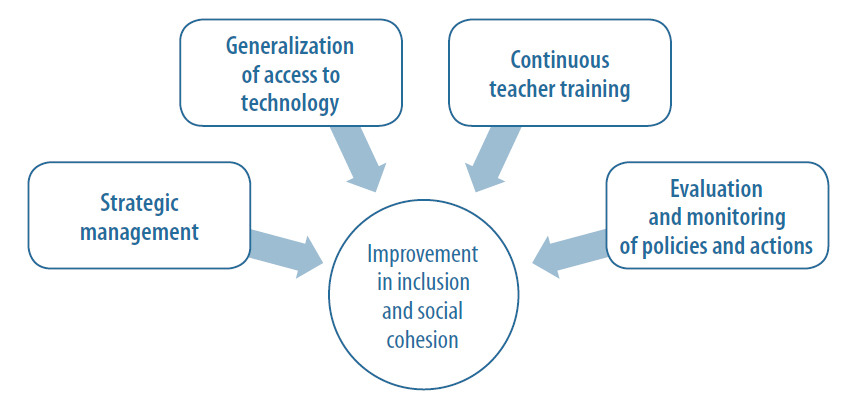
Source: Author’s own compilation
3.1. Factor 1: Strategic management
Our analysis of the international situation regarding ICT policies aimed at achieving greater levels of inclusion and social cohesion revealed the importance of possessing a set of variables associated with the management of such policies.
The management of ICT policies is a complicated topic to analyze because of the multitude of dimensions involved in its definition, which includes political, economic, cultural, administrative, technological, pedagogical and organizational variables.
There are enormous differences between developed countries and poorer ones, between countries with centralized political systems and those with decentralized ones, and between culturally and linguistically homogeneous countries and those that are not (UNESCO, 2013a and 2013b) (OECD, 2014).
With this framework, we have identified elements and lines of action that are common to the various contexts, which can and should later be defined in accordance with their particular circumstances:
- There is a need to design policies in the medium and long term. To guarantee continuity over time, these policies should be the result of dialogue, coordination and agreement between the various social agents and should remain in effect beyond the fixed periods of government.
- Continuity of these policies over time should be accompanied by technical and financial sustainability. ICT policies aimed at achieving social inclusion require a significant financial investment that should aim not only to make computers and other technological devices available but also to provide an infrastructure that enables this equipment to be used to the fullest.
- The processes and results of the policies should be evaluated systematically and the information produced by these evaluations should be widely disseminated among all the social actors involved.
- To lend coherence and rationality to these policies, they may need to be designed within the framework of strategic plans, which should define the goals, time periods, participating institutions, and evaluation mechanisms.
With regard to strategic management, we make the following proposals at various levels:
Table 1. Proposals for strategic management

Source: Author’s own compilation
3.2. Factor 2: Generalization of access to technology
Accessibility is the ethical principle that guarantees the right of all members of society to use products and services, other things being equal.
The most general hypothesis guiding many studies in this field assumes that a society and an economy that are based on the intensive use of knowledge simultaneously produce phenomena of greater equality and greater inequality, of greater homogeneity and greater difference, and of greater levels of inclusion and greater levels of exclusion (Tedesco, 2000).
With regard to the increase in inequality, data on the evolution of the distribution of income in the last few decades reveal that although inequality between countries is decreasing (IWS, 2013), due to the economic growth of the so-called “emerging countries”, inequality within countries is increasing (World Economic Forum, 2014).
Data on the distribution of ICTs on the international stage reveal the significant inequality in access that exists depending on the levels of social development. For example, if we take OECD countries at the beginning of the present decade as reference (OECD, 2007 and 2010), we can see that while Internet access is practically universal in countries such as Korea, the Netherlands, Iceland, Norway, Sweden and Denmark, only half of the homes in Greece, Turkey, Chile and Mexico have this access.
One component of digital exclusion has its origin in technical aspects that hinder the use of digital services. Especially significant is the non-compliance of regulations on matters pertaining to user rights and company responsibility, especially when it comes to accessibility (CERMI, 2010).
From our analysis we have identified the following lines of action, which are common to various contexts:
- The availability of free, public digital equipment, such as library networks, telecenters and free Wi-Fi access zones, is an option that promotes universal access.
- The “Design for All” strategy plays a key role in the creation of inclusive societies and should therefore be incorporated into all levels of the design process for goods and services.
- ICTs in education should adapt to the needs of all students, especially those with special educational needs.
With regard to promoting generalized access to technology, we make the following proposals:
Table 2. Proposals for promoting the generalization of access to technology
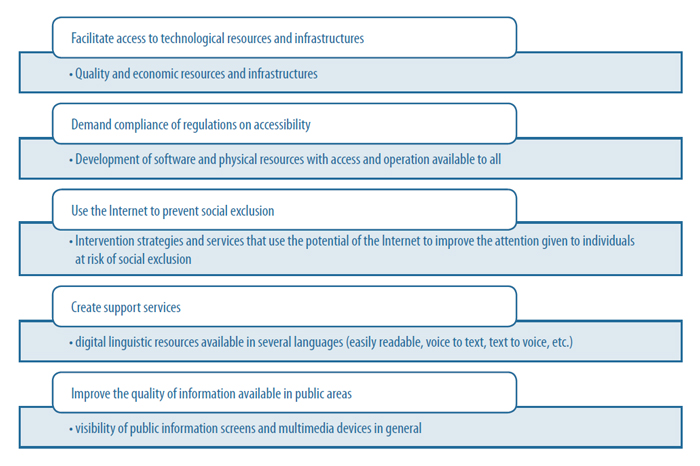
Source: Author’s own compilation
3.3. Factor 3: Continuous teacher training
Continuous teacher training (whether in terms of instructional design, content-creation or accessible ICT use) aimed at achieving greater levels of inclusion and social cohesion guarantees the implementation of internationally recognized good practices, increases the competences required by teachers, and prevents them from being used exclusively, which could occur out of a pure lack of awareness.
Although since the 1980s large-scale investments have been made in technology for schools, consensus is still needed on the approaches, indicators and methodologies required to analyze the use of technology, make a comparative evaluation, and study the effects on education. It was not until 2010 that an OECD study was conducted in this area (Joint Research Centre-European Commission, 2010).
As an example, in the case of Europe this study found that (Wastiau et al., 2013):
- The participation of teaching staff in ICT training courses for teaching and learning is rarely compulsory.
- In the EU, depending on the grade, only around 25%-30% of pupils are taught by teachers for whom ICT training is compulsory.
- Teachers are interested in using ICT, as is demonstrated by the vast majority of teachers who choose to develop their ICT skills in their own free time.
We know that this is the most generalized situation in the world and that it is probably the main reason for the low level of comprehension and knowledge about the accessibility criteria teachers should apply when creating educational content for an inclusive education.
From our analysis we have identified the following lines of action, which are common to various contexts:
- Initial training programs supplemented by continuous training programs should be established both on instructional design and the application of accessibility criteria via techniques that are adapted to technologies that continue to emerge.
- Support policies for existing networks and resource repositories should be defined in order to increase their range and attraction among teachers and guarantee their suitability for accessibility requirements.
- “Design for All” principles, instructional design strategies, and digital accessibility techniques should be essential components of teacher training at all levels.
- In addition to continuous training, continuous evaluation is also required. This should encourage teachers to allow themselves to be evaluated and to continue to apply and recognize good practices for inclusive education.
With regard to continuous teacher training, we make the following proposals, which are intended for the competent administrations:
Table 3. Proposals for continuous teacher training
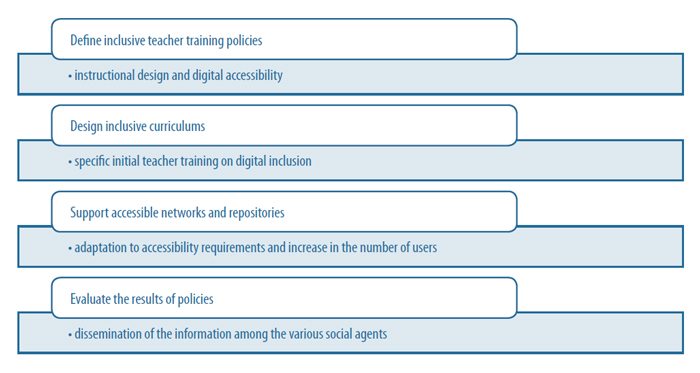
Source: Author’s own compilation
3.4. Factor 4: Evaluation and monitoring of policies and actions aimed at achieving digital inclusion and social cohesion
The relationship between the digital divide and social exclusion has received attention from public and private policies and initiatives both nationally and internationally (Joint Research Centre-European Commission, 2010; OECD, 2001, 2007, 2010; UNESCO, 2009 2013a, 2013b; World Economic Forum, 2014). Many reports, studies and discussions by experts have been devoted to this subject. However, despite all this information, no corpus of knowledge has been produced to analyze the situation and its evolution, study the policies and effects, or determine the criteria or variables that can help to narrow the digital divide and increase the level of social inclusion.
Experiences and studies have indicated positive results. However, these are limited to isolated data because they lack the structures that would enable comparison or analysis that could identify the key variables behind this success, thus limiting their possible extrapolation or transfer.
Information about initiatives undertaken often describe their development and results but do not analyze their effect or impact on social inclusion or the quality of life of citizens beyond the micro-context in which they took place.
Our review of the literature revealed a large number of publications on initiatives, experiences and investigations on technologies, the digital divide and social exclusion (Fundación Orange, 2014; Fundación Telefónica, 2012 and 2014; Cobo, C. and Moravec, J., 2011; Hurtado and Soto, 2008). However, this information has not led to a corpus of knowledge that could enable decisions to be taken about which policies to implement. As suggested by Helsper (2008), a change of approach is needed so that future studies and interventions will have a more defined and nuanced view of social exclusion and the digital divide.
From our analysis we have identified the following lines of action:
- Models or analysis structures should be promoted that include and communicate information and results that can be studied, compared, and replicated.
- Structures should be created that enable the information to be systematized and allow the policies and initiatives aimed at narrowing the digital divide and alleviating its effects on social exclusion to be evaluated and monitored.
- Rules and standards on digital inclusion should be promoted. Systems should be created that allow governments and institutions to evaluate the progress of policies aimed at narrowing the divide and achieving digital inclusion both nationally and internationally.
- Clear goals should be set for the policies and actions aimed at achieving digital inclusion. These should be incorporated into broader social and economic policies to allow these policies and their repercussions to be monitored.
With regard to the evaluation and monitoring of policies and actions to promote digital inclusion, we make the following proposals:
Table 4. Proposals for evaluation of policies
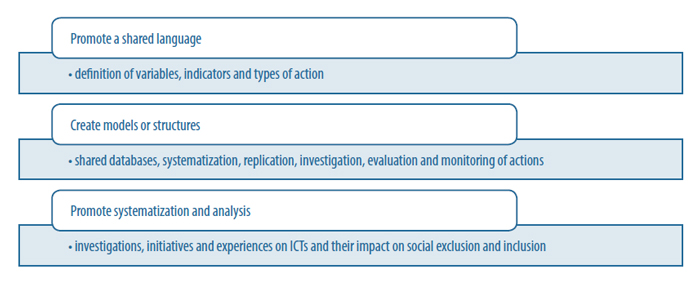
Source: Author’s own compilation
Next we present our conclusions, which are structured around the key factors for development we have identified.
4. Conclusions
The “Knowledge and Information Society” (UNESCO, 2005) requires citizens to be more digitally literate if they are to reach their full level of personal and professional development (OECD, 2010). In most countries exclusion risk factors exist that are associated with access to digital resources and the proper use of the Internet.
Figure 2. Key factors: strategic management

Source: Author’s own compilation
Figure 3. Key factors: Generalization of access
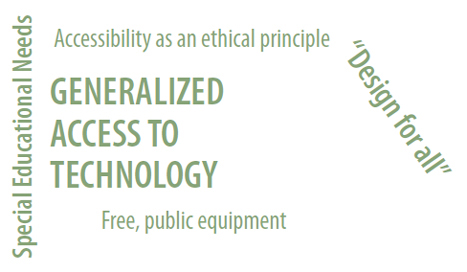
Source: Author’s own compilation
The “digital divide” highlights the need to introduce inclusive strategic education plans, where inclusion is understood as a continuous process that takes into account all individuals in society and their wide range of needs and that aims to enable individuals to participate in every sphere of society and reduce exclusion to the point of eliminating it (UNESCO, 2009; Fundación Orange, 2014).
Figure 4. Key factors: Continuous teacher training
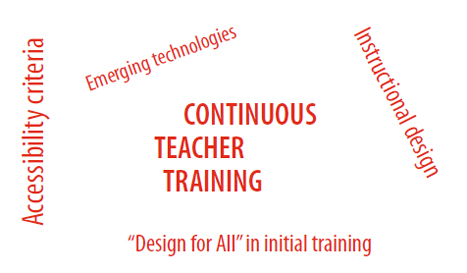
Source: Author’s own compilation
Figure 5. Key factors: Evaluation of inclusion policies
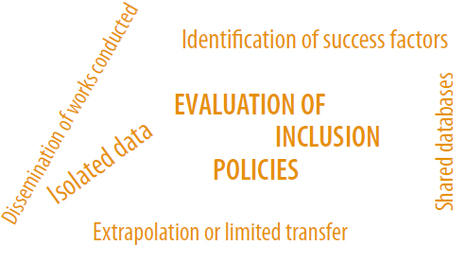
Source: Author’s own compilation
Digital inclusion should be approached from a global perspective. It should be considered the right of every individual not to be excluded from the society of the twenty-first century. Digital inclusion should also be considered a matter of social justice and a means to improving the quality of life of our citizens.
Any initiatives or actions to promote digital inclusion should aim to take advantage of the synergies provided by analyses of other initiatives or actions that have been or are being implemented and whose results may help to improve them. Inclusion is a dynamic process that is constantly evolving and advancing together with society, at a pace set by society, and in function of the needs of individuals generated by society.
In summary, a greater level of digital inclusion will improve the capacity of society in aspects such as accessibility to digital services, digital literacy, equality, the responsible use of technology, access to training, and entry to the labor market.




